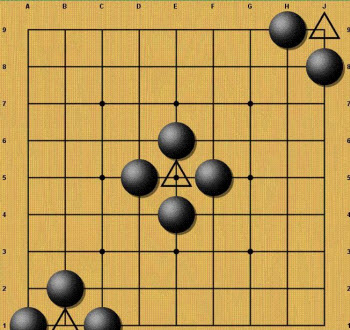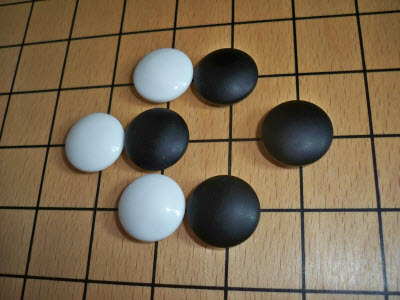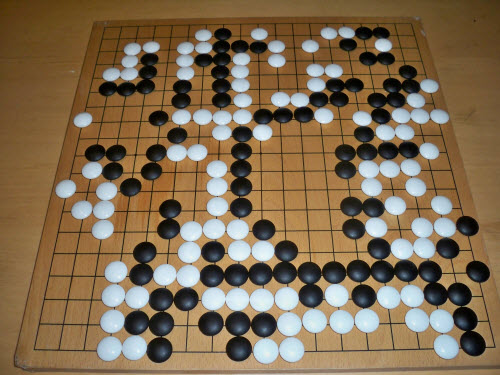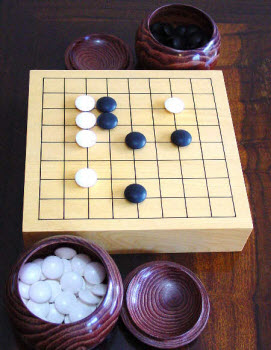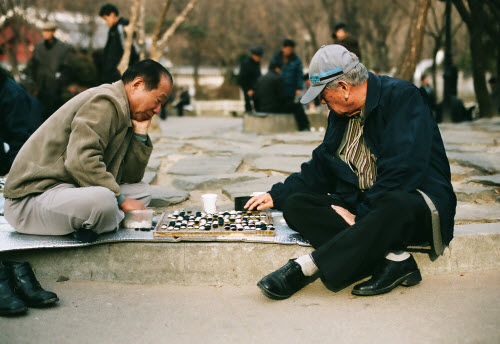The game of Go exists as one of the oldest and most enduringly popular games in the world, and somewhat paradoxically, in Western culture, also one of the least known. Like Mancala, Backgammon or Snakes & Ladders, it is one of several ancient games that have successfully lasted into the modern age, unlike its fellows Senat, Nardshir and Yut. What separates Go (or its original name, “Wei Ch’i”) from the other ‘Older Than Two Millennia’ board games is a depth of strategy that has been unequaled in all the years since its inception. It has been said that while its younger cousin Chess is a battlefield, Go is the war. No computer has ever beaten an expert Go player, and programming one to play succesfully is one of the challenges to proponents of artificial intelligence.
And it’s simple enough to be learned by five-year-olds.
Unlike many modern strategy games, the rules can be written on less than a single page of paper. There are no game phases to keep track of, no upkeep, no special movement rules, no need for a manual to check and double-check, and only two conditional rules to remember.
“Make a Fist Before Striking”
Go is the epitome of elegance in simplicity. Played on a 9×9, 13×13, or 19×19 grid, two players take turns placing black and white stones on the intersections of the lines. Once a stone is placed, it cannot be moved unless captured. Rather than moving pieces, maneuvering and tactics take shape in gradual formation building. The purpose of the game is to gain territory by surrounding parts of the board (empty points) with your stones. Whoever ends with the most points of territory, wins.
Yes, Go is likely the world’s first Area Control game.
You may capture opposing stones (or groups of stones) by surrounding them and cutting off all of their “liberties”. A stone’s liberties are the unoccupied spaces around it, connected by lines. For example, a piece in the middle has four lines leading out to empty spaces, so it has four liberties. A stone on the edge has three, and one in a corner has two. A stone or group that has only one liberty is in “atari”, and it can be captured in one move.
If stones are placed adjacent to each other, they are considered to be “connected” and treated as one group. Groups can be captured in the same way as individual stones, but this is harder to accomplish since a group of stones will have more liberties than a single one alone. Once stones are captured, they are removed from play , leaving empty space where they were. These stones are kept aside, and they will be subtracted from your score at the end of the game.
Nets Are Better Than Ladders
Remember how it was said there were only two conditional rules? That wasn’t an exaggeration. The first is a common sense one: you may never commit suicide by placing a stone somewhere where it would be immediately removed. The only exception to this is if placing that stone would result in the immediate capture of an opposing stone, thereby giving at least one liberty.
The second rule is the rule of “ko”. Essentially, players are prevented from capturing and recapturing the same stone every turn in a possibly endless loop. The most common shape a ko fight is found in is this:
If White were to capture the middle stone, Black could immediately play there again and take White’s stone. White could capture again, Black could recapture again, etc. Etc. The rule of ko simply says that in a fight like this, a player needs to play somewhere else first before retaking the ko. A common response is to play somewhere that directly threatens your opponent, forcing your opponent to play there rather than fill in and keep his formation at the ko.
The “L” Group Is Dead
The one essential concept any new player needs to understand is the idea of life and death. Quite simply, if a group can be captured, it is not “alive”. If you look at the above illustration of ko, you may notice that you can only play in the middle, the “eye” of the group, after it has been surrounded, making this “eye” the only liberty. If a group has two eyes, that is, two separate points of territory inside, it cannot ever be captured. If an opponent were to throw a stone in one eye, the group would still have a liberty in the other one.
And those are all the basics you need to play the game. This of course says nothing about strategy by a long shot, as there is quite literally more than a thousand years worth of literature detailing everything from basic strategy to in depth commentaries of historic matches.
Beginners Play Atari
There are several qualities to Go that stand out in particular compared to other games, but the four most prevalent are:
Balancing Skill Levels: First, and most importantly, is the handicap system. When a strong Chess player takes on a less experienced opponent, they won’t have much of a challenge. It may be a fun social and teaching experience, but their skills will not be heavily tested.
In Go, the weaker player starts with stones already on the board. The greater the gap in skill levels, the greater the advantage the weaker player gets. Using this sytem, two players of any two levels of experience can have an evenly matched, challenging experience. There are numerous games on the market that, while fun, puts new players at a huge disadvantage, and the more experienced player will sweep the board with you. Being able to keep the playing field level is a huge bonus to trying out a new game.
Lack of Randomness: Second, no dice. No chance. Go is a game of matched skill, eased by handicaps. You won’t have to worry about your success or failure being dependent on the roll of the die, or whether you or your opponent couldn’t draw the right card. If you win, the victory is yours.
Simple As Black And White: Third is the simplicity of concept. There are no pieces with different abilities to keep track, and there are no phases to remind yourself about. All the stones are the same. You don’t need additional rules to add different layers to the experience; there is no expansion that can add to it’s gameplay.
It is strategy at its purest, and because it is so simple, there are no easy outs for rules lawyering, no fine print to exploit, no hidden mechanics or ability combinations to let you dominate the play. There is a staggering level of complexity in Go, but it’s made up of what each player brings with them.
Scalability: Fourth is a variable game length. A full game of Go on a 19×19 board can be time consuming, and sometimes you’re looking for something quicker. The different board sizes allow for the game to be played to scale. A game on a 9×9 board stays short, sweet, and to the point.
Only After the Tenth Punch Will You See the Fist
Go, however, is not for everyone. In fact, several Archetypes are best to sidestep this old stalwart game entirely. Architects won’t enjoy that Go, like Chess, is a game of entropy. Rather than building places and resources up, you’re slowly losing them as you battle in a tete-a-tete for each other’s stones. And stones they are, nothing more. They are not knights or hotels or workers in a factory. Just stones. Immersionists can simply keep walking, as this ancient abstract game offers them nothing to get excited about. Likewise, Daredevils have little room for expression in a game that relies on sound tactics and a simple rule set. It’s not that Go isn’t capable of a player taking gambles, rather, it’s just that they don’t have the sort of payoffs this group will want.
By contrast, Go is the domain of the Tacticians, who will ultimately get the most appreciation out of it. Go is a test of ones wits against an even opponent, and with a myriad of strategies to use, Tacticians will enjoy flexing their mental muscle against a worthy foe. A Striker also will likely enjoy pitting themselves against another in a test of skill, but they will likely prefer the shorter game boards over the longer sessions. Socializers too may take an interest in Go – so long as the 9×9 board is used. The game is engaging enough with another player while still having simple enough rules that they can be written on a large napkin. If the game becomes prolonged, or their opponent not terribly up for conversation, however, their interest will quickly fade.
Go may not have a huge following in our part of the world, especially with the European preference for Chess as their parlor game of choice in the last couple centuries, but it would be foolish to dismiss a game outright because it hasn’t been the de facto tactics game of the west.
The opposite may actually be the case. Chess primarily stimulates the logical (left) side of the brain, whereas Go stimulates both hemispheres. Moreover, Go has a strong impact on the development of reasoning skills, especially in children. It is also thought to help brain activity in seniors, slowing or stopping the development of senile dementia. Both Go and Chess rely on simple rules bolstered by deep and complex tactical strategy. Both are pretty easy to learn, yet can take a lifetime to master. And both reward the patient.
Still, while Chess is the more familiar option between the two, Go is finding new inroads among a rising population of gamers. The expanding interest in board games in recent years has players not only looking forward with new innovations and designs, but there’s a portion showing a renewed interest in this wonderful time-honored game. Hey, we’ll take it.
Photo Credits: Go cover by Business Insider; Liberties diagram by Wikia; small Go board by Go Japan Go; Men playing Chess by Glenn Fiedler.

